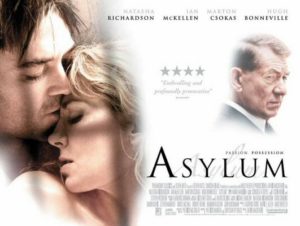 This British production seems destined to be remembered best for its troubled production history. It’s a solid work, though, a compelling romantic chiller with a first-rate performance by the late Natasha Richardson.
This British production seems destined to be remembered best for its troubled production history. It’s a solid work, though, a compelling romantic chiller with a first-rate performance by the late Natasha Richardson.
The basis of ASYLUM was a 1996 novel by Patrick McGrath, whose work was previously adapted for film in 1995’s GRAVE INDISCRETIONS (based on McGrath’s novel THE GROTESQUE) and David Cronenberg’s SPIDER (2002). The production of ASYLUM began in 1997, with Jonathan Demme on board as director. He left the project, as did Stephen King, who wrote a screenplay adaptation that was discarded. Another defector was Natasha Richardson’s husband Liam Neeson, who was set to play the male lead.
In retrospect the film, which was not a critical or financial success, plays very much like one of those highbrow British sex dramas that attracted controversy during the 1990’s (DARK OBSESSION, DAMAGE, PRIEST). The problem, then, was that ASYLUM arrived ten years too late.
Stella is the dissatisfied wife of Max, who’s just been appointed head of an insane asylum outside London. Finding her husband increasingly distant and sexually unresponsive, Stella becomes attracted to an asylum inmate named Edgar. He’s an artist with anger issues who murdered his wife. Stella enters into a perverse affair with Edgar, knowing full well the dangers of her actions. Observing them is Dr. Cleave, an asylum employee looking to manipulate events to suit some twisted inner agenda.
Edgar eventually breaks out of the asylum and takes refuge in a deserted shack. Stella leaves her husband and young son to join him. But Edgar’s murderous impulses manifest themselves with Stella, who appears to be going mad herself. Inevitably the police track Edgar down and Stella is returned to her home.
There Stella’s mental state continues to deteriorate. During a lakeside retreat with her son the boy drowns because of Stella’s inattentiveness. She’s placed in the inane asylum, where Edgar is also interned–and where Dr. Cleve keeps a watchful eye over both.
David Mackenzie directs in a stately, classical manner. The takes are on the long side and the pacing quite slow, at least by modern Hollywood standards. The sex scenes are reasonably graphic, at least enough to ensure an R rating, and would have likely raised eyebrows a decade ago–not now, however!
The film’s real spark is the lead performance of Natasha Richardson, who practically made a career of starring in underappreciated quasi-horror movies (including GOTHIC, PATTY HEARST and THE COMFORT OF STRANGERS). Looking great in a variety of revealing outfits, Richardson is both seductive and tragic playing a character that came off as little more than a cold-hearted bitch in the Patrick McGrath novel. Richardson also proves herself (not for the first time) a totally uninhibited performer, showing a startling amount of skin, and in the process delivering a deeply lacerating, soul-baring performance.
Vital Statistics
ASYLUM
Paramount Classics/Seven Arts
Director: David MacKenzie
Producers: Laurence Borg, David E. Allen, Mace Neufeld
Screenplay: Patrick Marber, Chrysanthy Balis
(Based on a novel by Patrick McCabe)
Cinematography: Giles Nuttgens
Editing: Colin Monie, Stgeven Weisberg
Cast: Natasha Richardson, Ian McKellan, Marton Csokas, Hugh Bonneville, Gus Lewis, Joss Ackland, Sean Harris, Wanda Ventham, Sara Thurston, Alwyn Taylor, Maria Aitken, Hazel Douglas, Anna Keaveney
